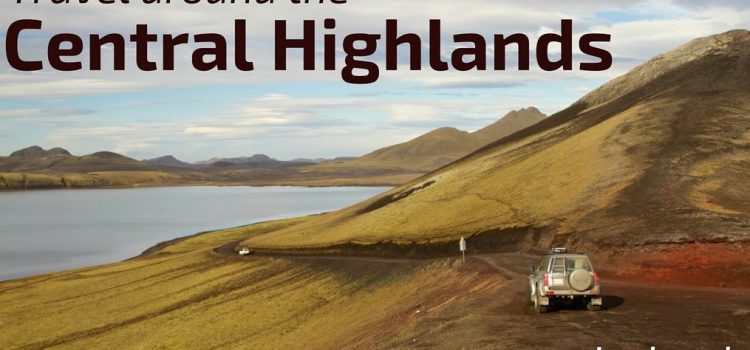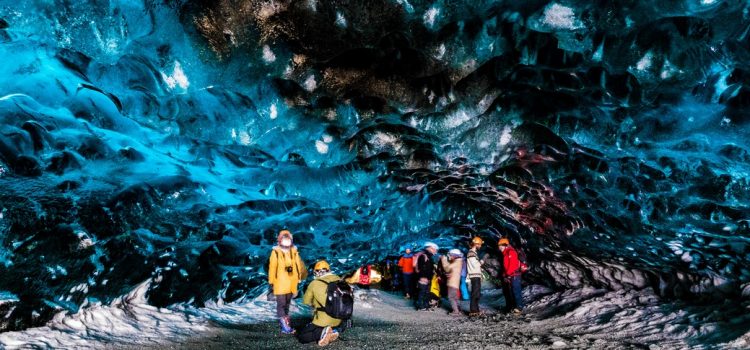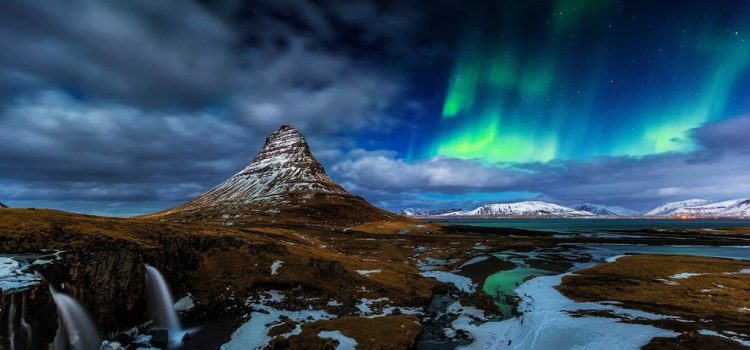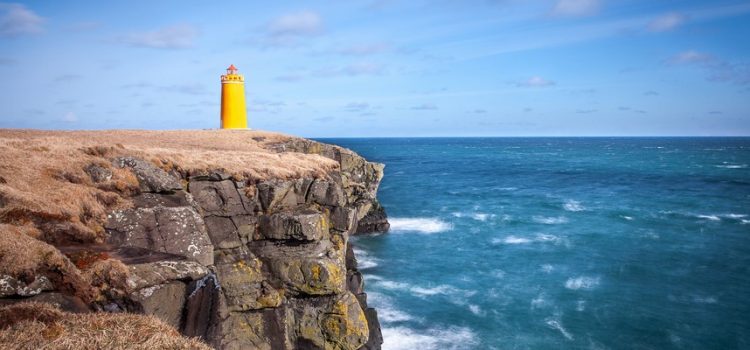The Central Highlands
Away from It All
If you really want to get away from it all, the interior of Iceland is like nothing you have ever experienced before. The mountainous centre of the island, with its rocky deserts, jagged mountain peaks, ice caps, volcanoes, hidden valleys and hot springs, is an awe-inspiring and untouched wilderness.
In the geothermal area of Landmannalaugar, nature has painted the rhyolite mountains in yellows, greens and reds interspersed with shiny black obsidian, and weary travellers can bathe in natural hot rivers. At Kverkfjöll, steam rising at the edge of the glacier has melted a series of bizarre ice caves. In the Dyngjufjöll range, the lake Öskjuvatn is situated in a large caldera (11 km2), and the crater Víti is filled with warm water. Both lakes were created in the wake of a gigantic eruption in 1875. The green, sheltered inland valley of Þórsmörk is a favourite with travellers, who use it as a base camp for hiking into the surrounding mountains. On the barren black sands of Sprengisandur, the arctic river beauty blooms bright magenta in August.
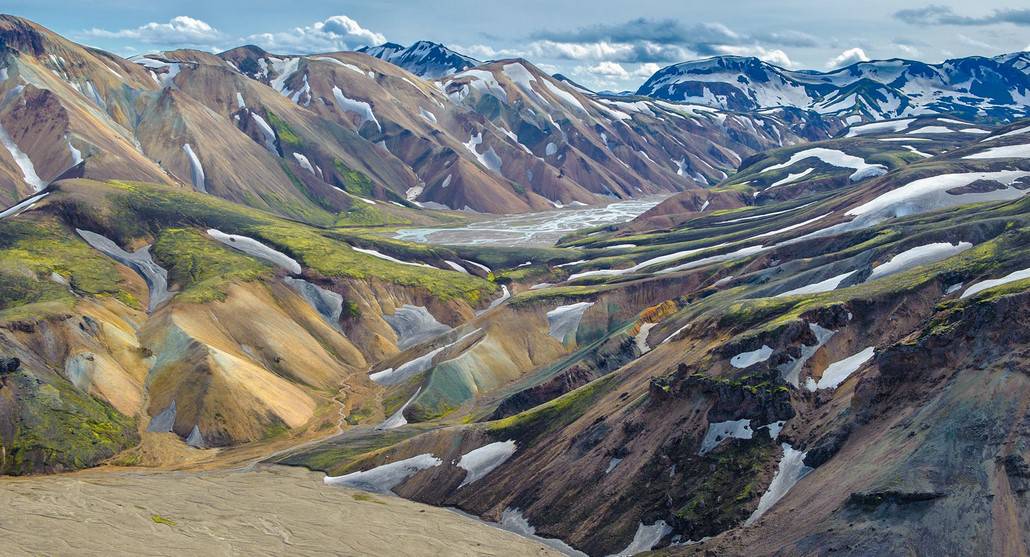
For centuries the interior was all but inaccessible. Outlaws hid for years at a time in the highlands, rustling sheep and keeping away from law-abiding folk. Fortunately, access is a lot easier today. The interior is traversed by two mountain roads, via Kjölur and Sprengisandur, which only open in the summer months, after the spring thaw.
Most highland routes involve crossing unbridged rivers, which should not be attempted without taking advice, and preferably travelling in convoy with other vehicles. Please note that if you rent a car, you cannot take it on a mountain road (classified F) unless it is a four-wheel-drive vehicle.
But the wonders of the highlands can also be seen by scheduled bus or on organised tours, which run regularly across the interior on the Kjölur and Sprengisandur roads, as well as to such destinations as Þórsmörk, Landmannalaugar, Mt. Askja and Kverkfjöll. Hiking tours are offered to many of the most popular locations in the interior. And one of the most memorable ways to see the highlands is on horseback, riding into the wide-open spaces, far from all human habitation.
East and Southeast Iceland
The East – Amazing Contrasts
In East Iceland, the visitor will be astonished by the variety and contrast of the landscape. You will find everything, from impressive fjords to friendly and peaceful fishing villages, from fertile and forested valleys to unique geological phenomena. All this is set against a background of impressive mountains and – farther away – Vatnajökull Glacier.

For the active tourist, there are superb hiking routes through verdant valleys and along high mountain ridges, both for those who prefer short hikes and for the passionate hiker who wants to go on for days and even weeks. The East Fjords are a magnificent landscape of long, narrow fjords, steep mountains and jagged peaks. This is one of the oldest regions of Iceland, which was shaped by glaciers in the Ice Age. Glacial action uncovered magma chambers that had been about 3 km beneath the surface, where zeolites had formed. These beautiful rocks can now be seen along the coast; for example at Teigarhorn. Off the shore are grassy islands that can be visited by boat.
For people who are interested in culture and fun, a visit to East Iceland will be most rewarding. In the summer, there is at least one festival a week, with a great variety of themes: history, music, golf, art, sports, hiking, art for and by young people, love, fishing – you name it! Look at www.east.is to plan your stay!
The East Fjords have many natural harbours, and in the 19th century this led to the development of fishing villages, most of which still exist. These seaside communities have a special charm, and many of them have town festivals every year. A number of museums in the East Fjords focus on various aspects of local history: World War II, French fishermen who fished off Iceland a century ago, local artists and technology. Other exhibitions highlight nature: the region’s beautiful minerals, and the reindeer that roam the eastern highlands.
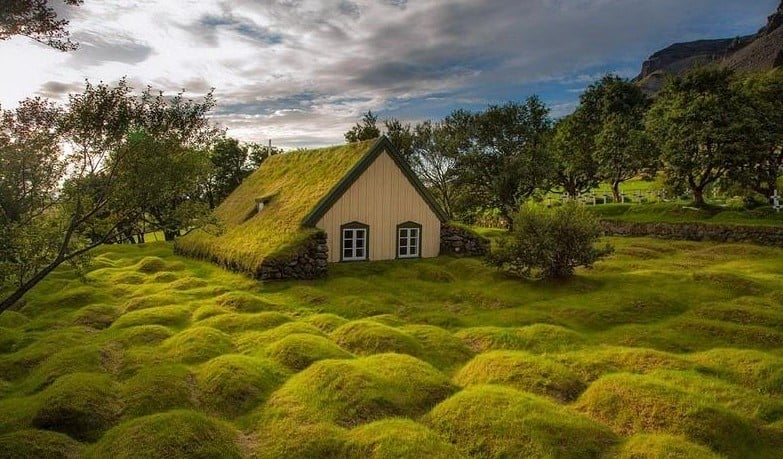
There are few places in Iceland where a human being feels as small and helpless as in the vicinity of Vatnajökull, Europe’s largest glacier. Everything here is on a grand scale: the lofty mass of the ice cap, the spectacular mountain peaks, and all the signs of volcanic activity beneath the ice.
But it is not only the craggy, rugged beauty of the region that is appealing. In places such as Lónsöræfi, Borgarfjörður eystri and elsewhere, the landscape exhibits an extraordinary palette of colours. In the realm of Vatnajökull, the land is greener, the glacier whiter, the volcanic sands blacker than anywhere else. This otherworldly environment has become a popular location for international film-makers and advertisers.
The southeast boasts a wide variety of birdlife, as most migrant birds arrive here, and many vagrant species are also carried here from mainland Europe.
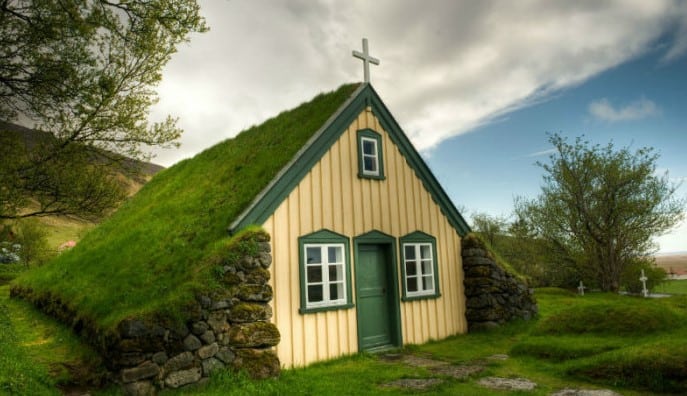
North Iceland
Summer Sun
Flourishing villages and farming communities, soaring mountain peaks, offshore islands and a landscape in formation make the North of Iceland a unique world of its own.
In the western part of the region, volcanic forces are no longer active, and since the end of the Ice Age the landscape has been moulded by rivers into smooth hills interspersed with some of Iceland’s finest angling rivers. On either side of Eyjafjörður rise high, ancient mountain ranges opening here and there into valleys, and in the north, marine erosion has created splendid cliffs. This area is popular with mountain hikers.
The Midnight Sun is an extraordinary spectacle in these northern latitudes: around the summer solstice, the sun sinks down to touch the horizon before rising again in breathtaking tones of red and gold.
Further east, other forces are at work: fresh lava flows, fissures and gullies are clues to recent volcanic activity. It is only a little over twenty years since the last eruption in the geothermal area adjacent to Mt. Krafla, and the unrest in the earth continues.

In ancient times a catastrophic glacial flood smashed through rock to gouge out the canyon of the river Jökulsá á Fjöllum and the huge sunken valley Ásbyrgi, which now form a magnificent National Park. Just a short distance away is the beautiful Lake Mývatn, famous for its picturesque natural surroundings, geothermal activity, and unique birdlife.
Most of the lowland areas have been inhabited since time immemorial by farmers and fishermen. In recent times remote spots such as the region east of Eyjafjörður, and Melrakkaslétta and Langanes in the far northeast, have become largely uninhabited, but they remain popular with travellers in search of peace and unspoiled nature.

Tourist services in the region reflect aspects of local history and ways of life. In Húnavatnssýsla and Skagafjörður visitors can see the sites of many of the important events in the classic Icelandic sagas. Seals can be observed at play offshore; the Selasetur seal center in Hvammstangi is an excellent place to gain insight into seals and their way of life. Whales can be spotted off Eyjafjörður and Skjálfandi bay, and Húsavík is home to a whale museum. In the first half of the 20th century, the “Herring Boom” brought unprecedented prosperity to many Icelanders, and the atmosphere of those times is recreated at Siglufjörður, one of the leading herring ports of the time. Another interesting destination is Hafíssetur, the pack-ice exhibition in Blönduós, where visitors can learn about “the land’s ancient enemy” through a graphic and text exhibition. Tucked away in the south part of Eyjafjörður is a very original museum: The Museum of Small Things (Smámunasafnið). Another very interesting museum, located at Svalbarðseyri, is The Icelandic Folk Art Museum (Safnasafnið).
Over the centuries, Icelanders relied on the horse for all transport and farm work, and Skagafjörður is especially famous for its horses and equestrian traditions, while horseback riding tours are available all over the north. Skagafjörður also offers the thrills of white-water rafting, and at the Icelandic Emigration Centre in Hofsós visitors can learn about emigration to the New World in the 19th century, when 20% of the population headed west in search of a better life.
The Capital of the North is Akureyri, a centre of education, culture and services in Eyjafjörður fjord. Akureyri has a full summer programme of events, arts, entertainment and activities.
Reykjanes peninsula
All You Need
Discover a lunar landscape pitted with volcanic and geothermal wonders, a surf-pounded coast where lighthouses outnumber villages, and where arguably the best sunsets in Iceland can be enjoyed. This rugged peninsula of raw natural beauty also boasts abundant wildlife and several top cultural and recreational attractions, including the world famous Blue Lagoon, the Viking Ship Exhibition, Power Plant Earth, and the Leira golfcourse, one of the best in Iceland – and it’s all just minutes drive from Keflavik International Airport.
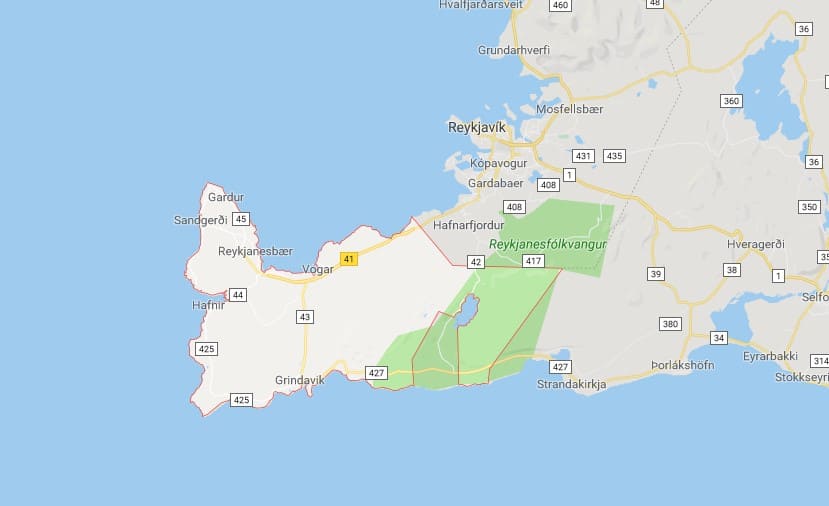
With all of this plus a choice of optional excursions and a range of hotel and guest house accommodation on the doorstep, Reykjanes is perfect for a short break offering a taste of the real Iceland.
Nowhere on earth is the junction between the European and American tectonic plates in the Earth’s crust as clear as on the Reykjanes peninsula in the southwest, and at Þingvellir: the plates diverge here by as much as 2 cm per year. But the gap is constantly being filled, as volcanoes have been erupting regularly throughout Iceland’s history.
Several high-temperature geothermal areas are found on the Reykjanes peninsula, two of which have been harnessed to generate electricity, at Svartsengi and Hengill. A further two geothermal power stations are currently under construction: Hellisheiði Power Station and Reykjanes Power Station. At Svartsengi, the Gjáin visitor centre explains geological history, and nearby is the Blue Lagoon spa, whose mineral-rich waters are internationally known for their curative powers.

From early times, habitation on the Reykjanes peninsula has been confined to the coast, and the population lived by the fisheries. Museums in Grindavík, Sandgerði, and other locations uphold the region’s seafaring traditions. This rugged peninsula of raw natural beauty also boasts abundant wildlife and several top cultural and recreational attractions, including Krýsuvík geothermal area, popular recreational destination with many interesting hiking paths, the Viking Ship Exhibition and the Leira golfcourse.
Reykjavík – Pure Energy
Recharge and Relax in Iceland´s Capital
Shaped by the energy of the earth, bustling with the energy of a cosmo-politan capital, surrounded by the pure unpolluted energy of nature, Reykjavík is a city of striking contrasts. Small corrugated iron houses nestle next to futuristic glass buildings; state-of-the-art facilities lie minutes away from rugged volcanic terrain; and inter-national influences mingle with Icelandic national traditions to create a unique culture where old embraces new.
Whatever your interests, Reykjavík has something to offer. Whether you are seeking the bustling energy of a cosmopolitan city, the thundering thermal energy in the ground beneath your feet, or the quiet green energy of the landscape surrounding the city, Reykjavík promises a memorable visit.

One way to soak up Reykjavík’s pure energy is to visit one of the many thermal swimming pools or spas. Whether you go for a swim, take a healing soak in a hot tub, or indulge in a thermal steam bath, you will leave feeling relaxed and re-energised. Going to the pool is also very much a way of life for Reykjavík’s residents and thus an ideal way to meet local people. A crash course in Icelandic politics, the long-term weather forecast, or some valuable tourist tips are just some of the things you might soak up in the soothing waters of a hot tub. There is no better way to touch the pulse of the city.
The magnificent countryside that surrounds the city also makes Reykjavík unique and provides the adventurous tourist with a wide variety of things to do. Salmon fishing, midnight golf, sailing, climbing, glacier trekking, horse riding and whale watching are all within easy reach of the capital and can easily be fitted into a day trip so that you can be back in the city in time for dinner.
Reykjavík boasts an excellent range of fine restaurants that are renowned for their imaginative cuisine and fresh local ingredients. Whether you enjoy seafood, lamb or wild game, there will be something on the menu to suit your palate. For a city of its size – Reykjavík and its neighbouring communities have around 200,000 inhabitants – Reykjavík also boasts an excellent range of luxury hotels, exclusive shops and designer outlets. It also has the reputation of being one of Europe’s “hottest” cities at night, with an active music scene and famous nightlife.
Reykjavík is energy also abounds in the city’s cultural scene. From the avantgarde to the historical, Reykjavík’s galleries, museums and theatres support a vibrant yet sophisticated artistic culture. Annual festivals, special exhibitions and stage productions mean that the cultural calendar is always full and there is always plenty for the visitor to enjoy.
Reykjavík is the gateway to Iceland. A young-at-heart city with a long history, encircled by mountains and sea, it lies just minutes away from a magnificent unspoiled landscape thrown up and shaped by the energy of the earth. Whether you are looking for the excitement of a capital city or a quiet break in breathtaking scenery, Reykjavík has everything you could possibly want. Reykjavík – pure energy – you’ll leave revitalized.
The Capital Area
Reykjavík’s neighbouring communities are also well worth a visit. In the town of Hafnarfjörður, Viking culture is still alive and well: the restaurant Fjörukráin organises Viking banquets all year around, and the town also hosts the annual international Viking festival. People come from all over the world to demonstrate how the Vikings did battle, carved wood and bone, wove fabric, and made ornaments and weapons. And of course there is Viking food and music to be enjoyed. And before you leave Hafnarfjörður, why not take a look at the small but beautiful Hellisgerði park?
Between the towns of Kópavogur and Garðabær, there’s a big shopping mall called Smáralind where many cultural events are organised, including exhibitions, concerts and song contests. Kópavogur also has an art gallery (Gerðarsafn) and a Natural History museum.

In Seltjarnarnes, to the west of Reykjavík, there is a medical museum at Nesstofan, housed in one of the oldest buildings in Iceland, which dates from 1761–1763. To the north, the community of Mosfellsbær has a museum devoted to the Nobel-prize-winning (1955) author Halldór Laxness.
Like the city itself, all the communities around Reykjavík boast golf courses, presenting you with quite a choice! And of course, all have wonderful open-air thermal pools, most of which also provide fitness facilities.
Just outside the urban area, the Heiðmörk nature reserve offers opportunities for walking, mountain biking or horse trekking. There are also riding stables in Hafnarfjörður and Mosfellsbær, where you can try out Icelandic horses which are very different from other breeds. Although small, they are extremely strong and sturdy, with five gaits, two more than most other horse breeds. One of these, the “tölt”, is extremely comfortable for the rider and can be sustained over long distances.
Reykjavík is a convenient starting point for all kinds of excursions, which enable you to explore a large part of Iceland without so much as having to pack a suitcase. In addition to bus tours to all the “must-see” places, domestic flights can be taken to destinations that are further afield. Whale-watching boat trips are available from late March until mid October, and for those who like some real action, biking, hiking, angling, diving, river rafting, skiing (in winter) and kayaking are justsome of the activities on offer.

